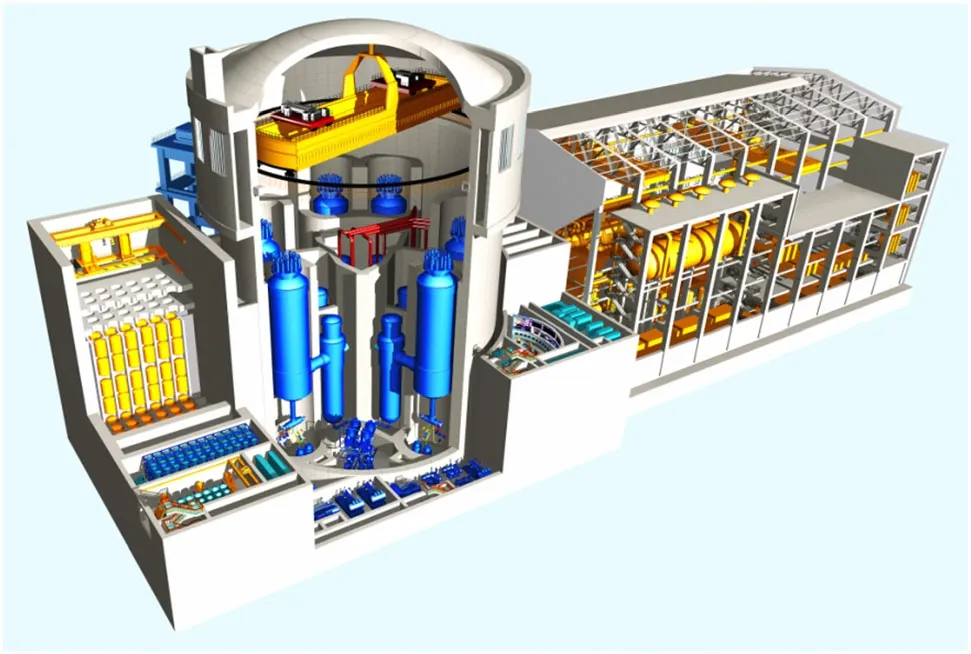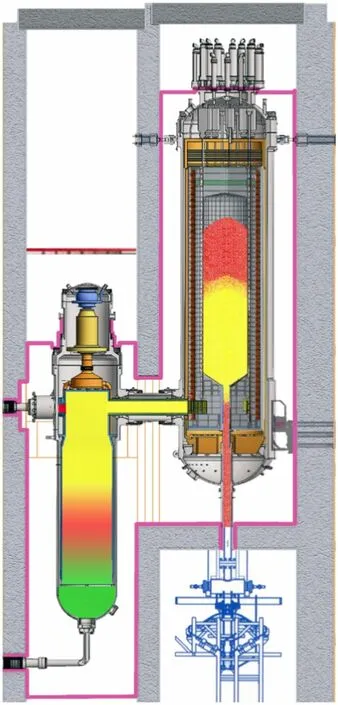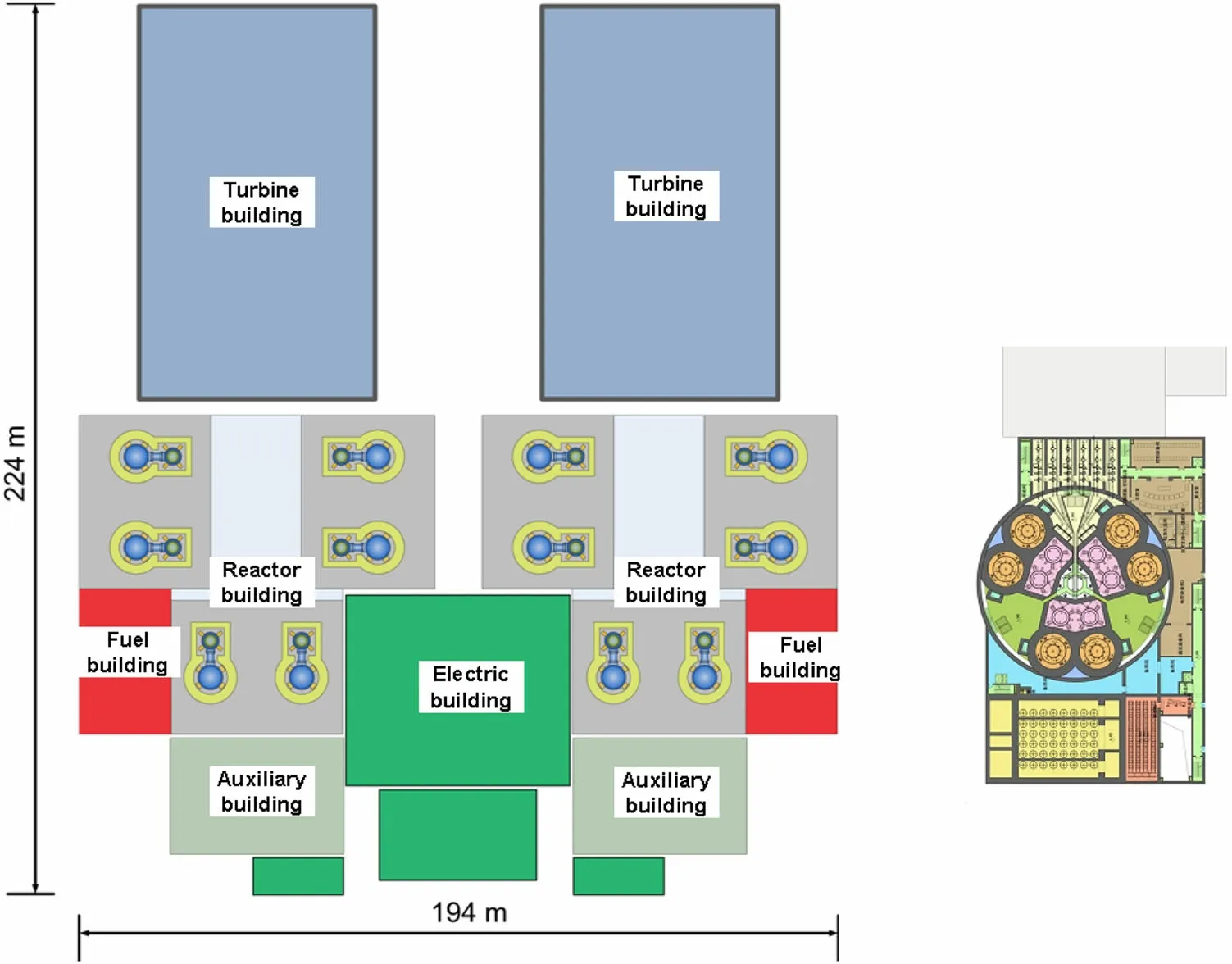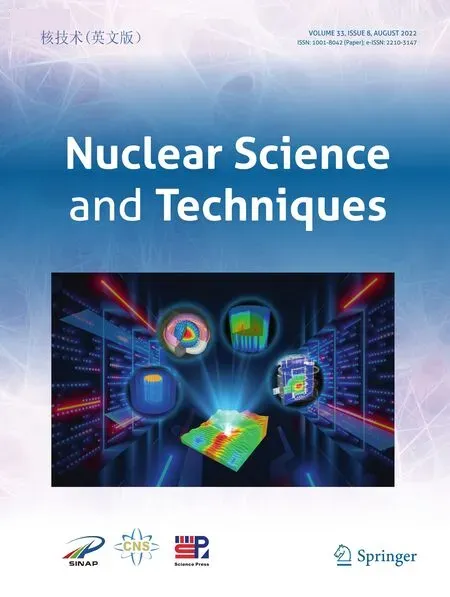600-MWe high-temperature gas-cooled reactor nuclear power plant HTR-PM600
Zuo-Yi Zhang · Yu-Jie Dong· Qi Shi · Fu Li · Hai-Tao Wang
Abstract The HTR-PM600 high-temperature gas-cooled reactor nuclear power plant is based on the technology of the high-temperature gas-cooled reactor pebble-bed module (HTR-PM) demonstration project. It utilizes proven HTR-PM reactor and steam generator modules with a thermal power of 250 MWth and power generation of approximately 100 MWe per module. Six modules in parallel, connected to a steam turbine, form a 600-MWe nuclear power plant.In addition,its system configuration in the nuclear island is identical to that of the HTR-PM in which the technical risks are minimized. Under this principle,the HTR-PM600 achieves the same level of inherent safety as the HTR-PM. The concept of a ventilated lowpressure containment (VLPC) is unchanged; however, a large circular VLPC accommodating all six reactor modules is adopted rather than the previous small-cavity-type VLPC,which contains only one module,as defined for the HTR-PM. The layout of the nuclear island and its associated systems refer to single-unit pressurized water reactor(PWR) practices. With this layout, the HTR-PM600 achieves a volume size of the nuclear island that is comparable to a domestic PWR of the same power level. This will be a Generation IV nuclear energy technology that is economically competitive.
Keywords High-temperature gas-cooled reactor ·Module · HTR-PM600 · Generation IV
1 Introduction
The pebble-bed high-temperature gas-cooled reactor(HTGR) originated with the invention of Schulton R in Germany. Two pebble-bed HTGRs, namely the 45-MWt AVR pebble high-temperature gas-cooled experimental reactor and 750-MWt THTR high-temperature gas-cooled reactor demonstration power station [1],were successively built. The concept of a ‘modular’ HTGR technology with inherent safety features was proposed by Siemens/Interatom [2] in the 1980s. Based on this concept, a 200-MWt modular pebble-bed HTGR called the HTR-Module was developed in Germany.Unfortunately,construction has not yet been implemented.
In China, a 10-MWthhigh-temperature gas-cooled experimental reactor, the HTR-10, was designed and constructed, at the Institute of Nuclear and New Energy Technology (INET) of Tsinghua University, under the leadership of Wang et al.[3].The HTR-10 reached its first criticality in 2000, laying the foundation for the development of HTGR technology in China.In 2006,the project of a 200-MWe high-temperature gas-cooled reactor pebblebed module nuclear power demonstration plant(HTR-PM)was supported by major national science and technology projects in China [4]. After a rigorous nuclear safety review, before and after the Fukushima Daiichi Nuclear Power Plant accident, the HTR-PM was approved, and the first concrete was poured on December 9, 2012, at the Shidao Bay site in Rongcheng,Shandong Province,China.After construction and hot tests, the HTR-PM reached its first criticality on September 12,2021[5].It was connected to the grid for the first time on December 20,2021.The site view of the HTR-PM plant is shown in Fig. 1.Several key technologies and equipment have been researched and developed by the major national science and technology projects supported by China. The associated full-scale engineering verification experiments were carefully scheduled and completed in a hot helium environment,which provided technical support for the nuclear safety view of the HTR-PM [6].
The HTR-PM uses the technical foundation formed from HTR-10 in China and draws as much as possible from the design concept of the German 200 MWthHTR-Module.Since the German HTR-Module has not yet been implemented, HTR-PM can only use Chinese factories and the engineering technologies available for the overall design of the reactor and its specific equipment, thus overcoming many difficulties and achieving several major technological engineering innovations [6].
As a follow-up commercial version of the HTR-PM,the goal of the HTR-PM600 high-temperature gas-cooled reactor nuclear power plant is to use a proven HTR-PM reactor and steam generator module with a thermal power of 250 MWthand a power generation of approximately 100 MWe. Six modules in parallel, connected to a steam turbine, form a 600 MWecommercial scale HTGR nuclear power plant.Since 2013,the HTR-PM600 has been jointly developed by INET and the Chinergy Co.,Ltd of the China National Nuclear Corporation (CNNC). The design of a standard HTR-PM600 was completed in 2016.

Fig. 1 (Color online) 200 MWe HTR-PM high-temperature gascooled reactor nuclear power demonstration plant in Shidao Bay,Shandong Province, China
2 Overall requirements
An essential concept of the modular HTGR is the‘module’ itself. Based on the module, inherent safety is achieved at a relatively low reactor power level. ‘Module’also indicates that a power plant with multiple reactor modules can be used to achieve an economically competitive large plant size [2].
The HTR-PM demonstration plant uses two reactor modules to connect one steam turbine to achieve a power generation level of 200 MWe.Under minimum capital risk,it achieves industrial demonstration and verification. The use of two modules is a start for verifying the technology of connecting multiple reactor modules to one steam turbine.
In terms of safety, the HTR-PM reactor module can ensure that the reactor core will not meltdown in any conceivable accidents, as no electricity, coolant, valve action, or human intervention is required. This feature can be subjected to rigorous deterministic verifications,including (1) using the laws of physics to prove its accordance with the deductive method and (2) full-scale real-reactor safety verification experiments.
The adoption of multi-module reactor technology does not limit the further increase in the power level of the HTGR nuclear power plant within a certain range. However, we limited the power of the HTR-PM600 plant by a scale of 600 MWe, in version 1.0. In addition, we placed emphasis on retiring coal-fired power plant alternatives and cogenerating heat and power for industrial heat applications for the targeted domestic market.The HTR-PM600 is dedicated to achieving the same level of inherent safety with the HTR-PM.Public acceptance of nuclear energy can be maximized by full-scale reactor safety demonstration tests on the HTR-PM600. A nuclear power plant of this type is considered be an economically competitive Generation IV nuclear energy technology [7].
The overall design principle of the HTR-PM600 is as follows:
1. Based on the proven technology of the HTR-PM demonstration project, it fully absorbs the experiences gained from this project. However, no additional research was required.
2. To maintain the safety features already achieved in the HTR-PM demonstration plant,the knowledge obtained and consensus reached during the safety licensing process of the HTR-PM can be closely referenced.
3. To reach a certain degree of economic competitiveness,the gap between Generation III pressurized water reactor nuclear power plants and the HTR-PM600 version 1.0 should be within a limited range. For example,the gap in the total plant costs was set within 10–20%. If special factors, such as site selection and cogeneration requirements, are taken into consideration, it is expected to be commercially acceptable.Version 2.0 aims to achieve full economic competitiveness in the energy market.
3 Nuclear power plant design
The three-dimensional design of the HTR-PM600 nuclear power plant in the form of a single unit [8] and its layout are shown in Figs.2 and 3,respectively.The nuclear island of the HTR-PM600 is an integrated building structure that consists of a containment, fuel plant, nuclear auxiliary building, and electrical building. The six HTRPM modules are arranged in a circular shape inside a circular containment. In each module, the reactor is outside and the steam generator is inside. Six main feedwater and steam lines are introduced and extracted from the central concrete compartment in the containment.
The reactor module is the same as that found in the HTR-PM demonstration plant. Each power is 250 MWth,the core diameter is 3 m,and the height is 11 m.On top of the reactor, there are 24 control rods, their drive mechanisms, and six sets of small absorption sphere shutdown systems.The steam generator has 19 tube assemblies,each with 35 heat transfer tubes.A helium circulator is mounted on the upper part of the steam generator. The reactor and steam generator pressure vessels are arranged side by side,with a hot gas duct pressure vessel in between. Based on the HTR-PM demonstration plant, a standardized design concept was adopted to ensure that the design drawings of each reactor and steam generator module were identical and could be processed with one set of drawings, with interchangeability. The vertical section of the reactor and steam generator module is shown in Fig. 4.

Fig. 2 (Color online) 3D design of the HTR-PM600 nuclear power plant [8]
The containment is a ventilated low-pressure containment (VLPC). Its gas-tight requirement is less strict than that of a PWR nuclear power plant.The containment of the HTR-PM600 is a large circular concrete structure containing all six reactor modules and their associated concrete cavities, unlike that of the HTR-PM, which specifies the boundary of containment to two small concrete cavities that accommodate only one reactor module. With a much larger volume, and a design pressure of 0.05 MPa, helium released from one or two modules in an extreme accident will not cause blasting of the containment bursting disc.The helium and radioactive contents it carries (e.g., graphite dust) will be temporarily retained inside the containment and then discharged to the environment slowly,through a filtered ventilation system.
Outside the containment, the fuel plant, nuclear auxiliary building, and electrical building are arranged in reference to the layout of well-known PWR nuclear power plants. The fuel plant is placed on the left side of the containment (Fig. 3). Between them, fresh fuel transportation channels and spent fuel transportation channels are arranged. The design of the spent fuel dry storage region closely resembles that of the HTR-PM demonstration plant. A total of 48 spent fuel canister wells are arranged, each accommodating five spent fuel canisters.The total storage capacity is 240 canisters.Each spent fuel canister has a volume of 40,000 spherical spent fuels.With this capacity, the fuel plant can store approximately 12 years of spent fuels in full power operation. Closedventilation cooling is used during normal operations to limit the long-term effects of outside air on the canister surfaces. When normal ventilation is lost, the ventilation mode can be automatically shifted to open-air natural circulation to carry out the decay heat from the spent fuel storage region.
The nuclear auxiliary and electrical buildings are arranged on the lower and right sides of the containment building, respectively (Fig. 3). The nuclear auxiliary building accommodates the helium purification and storage system, as well as the helium flow part (including small helium circulators and associated small-diameter helium pipes) of the fuel-handling system. The rest of the fuelhandling system, namely the high-pressure fuel circulation pipelines connected to the primary circuit and its connected equipment, are arranged inside the containment. The electrical building accommodates a reactor protection system, main control room, and safety-grade electrical equipment.
In addition to the buildings with a certain safety grade,there is a conventional-grade nuclear island annex building with a sanitary channel, non-safety-rated instruments,electrical systems, and a nuclear island ventilation system.The HTR-PM600 does not require a safety grade diesel engine.

Fig. 3 (Color online) Plan layout of the HTR-PM600 nuclear power plant

Fig. 4 (Color online) Vertical section of an HTR-PM reactor and a steam generator module
As a design principle,the functions and module sharing modes of the safety systems and auxiliary systems are identical to those of the HTR-PM. That is, each reactor module has a separate safety system and a set of fuel handling systems;other auxiliary systems such as the fresh fuel supply system, spent fuel storage system, helium purification, storage system, equipment cooling water system, plant cooling water system, ventilation, and nonnuclear-grade electrical systems are shared by modules.
Considering that the spent fuel storage system serves six modules rather than two,but that its volume size is close to that of HTR-PM, in-service transportation of spent fuels is required. To use the currently available technology to minimize risks,spent fuel storage canisters are designed to be loaded onto PWR spent fuel transport containers for transportation away by vehicles. For a multi-plant site, a spent fuel intermediate storage facility can be constructed,on site,to contain the spent fuel produced during the entire lifetime of all HTGR plants. In the case of several multiplant sites, it is also possible to build a regional intermediate storage facility that accommodates spent fuels at all sites. The intermediate storage is air-cooled. The basic design can closely resemble the spent fuel building of the reactor.
In the decommissioning phase, spent fuel can be processed in two ways. First, there is final storage after conditioning where the graphite matrix of the spent fuel is separated from the TRISO fuel particles. The TRISO fuel particles are then placed into a final storage container and sent to a geological storage facility. The resultant stored spent fuel volume and residual heat are estimated to be comparable to those of glass-solidified blocks produced after PWR nuclear power plant re-processing. Second, the graphite matrix is separated from the TRISO particles,and the TRISO particles are broken-down, thereby separating the UO2fuel kernels from their coatings. After nitric acid dissolution,UO2can be added to the conventional PUREX process for reprocessing.The choice should be made based on technological economy and environmental impact considerations.
The primary design parameters of the HTR-PM600 plant, in the form of a single unit, are listed in Table 1.

Table 1 Main design parameters of the HTR-PM600 nuclear power plant
4 Main design considerations
4.1 One unit with multiple reactor modules
One unit of the HTR-PM600 is multi-modular (six modules), complete, and independent. There is a main control room, a steam turbine generator, and an operator team. It is feasible to increase the ability of the unit to adapt to the grid load regulation by shutting down or starting one or several modules. Each reactor module can be started individually, shut down, and operated at various powers. The helium between the modules is disconnected and can operate under different pressures.It is also possible that one or more of the modules are shut down for certain maintenance, whereas the other modules are capable of operation. However, overhaul in the containment is a common action of the entire unit.
For the 200-MWeHTR-PM demonstration plant, there are two reactor operators,one conventional island operator and one team leader in the main control room.Based on the experience gained from the demonstration plant and simulations using the HTR-PM600 simulator,the ability of the operator to handle the two modules is verified according to the operation procedures. Therefore, it is feasible to have three reactor operators, one conventional island operator,and one team leader in the main control room of the HTRPM600. Each reactor operator starts the reactor modules,not in parallel, but sequentially. In accordance with the principle of gradual and orderly progress, the number of operators will gradually be reduced in future projects.
When calculating the risk of a unit, the following formula is used to superimpose the consequences of the risk category i and the results from different modules j:

That is,when the risk is calculated,the frequency of the initiating event Piis assumed to remain unchanged, owing to the increase in the number of modules. The effect of multiple modules can be considered by adding the consequences of different modules Cij.
4.2 Arrangement of the nuclear island
In the HTR-PM demonstration plant,we use two reactor modules, arranged side by side (Fig. 5). In the regions below, in each module and in-between two modules, two sets of fuel-handling systems are arranged. We studied the T-scheme in the early phase (left side of Fig. 6) of the HTR-PM600 [6] and finally selected the circular scheme (right side of Fig. 6). The main considerations were the size of the nuclear island,amount of concrete,and major pipeline orientation. Compared with the HTR-PM rectangular reactor building, a circular building of an equivalent volume is suitable for accommodating more reactor concrete cavities, each with a circular cross section. The volume data from various plants in different schemes (Table 2), indicates that the HTR-PM600 has a nuclear island volume comparable to that of the domestic PWR plant, of the same power level. The advantages of adopting the circular scheme include the following: (1)reduced volume of the reactor building; (2) optimized arrangement of the steam and feedwater pipes; and (3)references of industrial foundations and experiences from PWR nuclear power plants. Simultaneously, the circular scheme shows that the fuel handling system is arranged in a fan-shaped space between the two modules. This consideration ensures that the original twin-module layout of the HTR-PM can be referenced to a significant extent.

Fig. 5 (Color online) Two-module arrangement of the HTR-PM demonstration project

Fig. 6 (Color online)Comparison of the different HTR-PM600 plant schemes

Table 2 Volume of the different nuclear island buildings(taking the value of 1.0 as a reference for HTR-PM)
When using the circular scheme, we found that the difference between the HTR-PM600 and PWR nuclear power plant, in terms of the nuclear island configuration,was mainly in the containment. The PWR has one set of nuclear steam supply systems (NSSS), whereas the HTRPM600 has six. Except for this difference, the layout,principles, and the size of the remaining buildings were roughly the same. The same layout principles, equipment,and customary passages can be used to facilitate the construction of the HTR-PM600 in a construction and equipment manufacturing environment, which is similar to that of conventional PWR nuclear power plants.
4.3 Safety
The safety basis of the pebble-bed modular HTGR is that even if a single-module reactor loses cooling,the maximum temperature of the fuel element does not exceed 1620 °C,solely due to the heat conduction and heat radiation from the pebble core [9, 10]. For the HTR-PM600, the design parameters, operating parameters, design criteria of the reactor module, and the associated reactor cavity cooling system (RCCS) are exactly the same as those of the HTRPM. Although all reactor modules share one large circular VLPC,each reactor module retains its own concrete cavity,as in the HTR-PM design, which provides physical protection to the reactor module and the associated in-cavity part of the RCCS.In addition,six RCCS air-cooling groups,each including three independent air cooler arrays, are placed around the upper part of the containment, on the outer surface side, and physically separated. In this way, (1) each reactor module is physically independent and isolated from others;and(2)in the event of an accident,one single reactor module would not compromise the safety of other reactor modules. Therefore, the safety features of each module are identical to those of the HTR-PM module.
4.4 Technical readiness considerations
The reactor modules, including both the reactors and steam generators,are identical to that of the HTR-PM.The main systems and components of the HTR-PM in the primary loop, such as the reactor pressure vessels, steam generators,reactor internals,helium circulators,control rod systems, and small absorption sphere systems, remain unchanged. The main tasks are to optimize manufacturing processes and standardize production in batches to minimize costs.
4.5 Economic considerations
When we compare a domestic 600-MWePWR nuclear power plant with the HTR-PM600,we can see that the size of the nuclear islands is similar.Therefore,their civil costs should also be equivalent. The main difference is in the equipment used. A PWR has one NSSS plus complicated,redundant safety systems(e.g.,emergency core cooling and containment cooling systems), whereas the HTR-PM600 has six NSSS modules and significantly simplified safety systems. In domestic PWR nuclear power plant construction, the costs of the reactor pressure vessel (RPV) and reactor internals,which are key components of the NSSSs,are only approximately 2% of the total plant costs [11]. If we assume that other equipment costs are unchanged, then the total plant costs will be increased by 20%, even if the costs of the RPV and reactor internals are conservatively increased ten times.This takes into account factors such as the increased number of NSSS modules, increased RPV weight, and simplified RPV manufacturing without the need for stainless steel cladding. Based on these assumptions and considerations,it has been estimated that the total cost difference of a domestic 600 MWePWR and HTRPM600 would not exceed magnitudes of 10–20%, as detailed in[6]and[11].The key economic challenge of the HTR-PM600 lies in reducing the costs of the six NSSSs.It is also worth discussing safety reclassification of the reactors, steam generator equipment, and associated safety systems,based on the safety features of the HTR-PM600.If such reclassification is possible, there would be enough room to further reduce the cost of NSSSs.
In addition, the HTR-PM600 may achieve a radioactive dose of less than 10 mSv,and even 1 mSv,if it is required at the site boundary under the site evaluation accident sequence.Therefore,technically,no emergency evacuation area is required outside the site boundary, which will greatly facilitate site selection. It is estimated to result in cost savings of approximately a billion RMBs.
5 Conclusion
The HTR-PM600 high-temperature gas-cooled reactor nuclear power plant is a follow-up commercial version of the HTR-PM demonstration plant. Its design closely resembles HTR-PM technologies, systems, and equipment proven in the demonstration project. Six HTR-PM reactor modules, in parallel, were connected to one steam turbine to form a 600-MWescale high-temperature gas-cooled reactor nuclear power plant. Under this design principle,the same level of inherent safety as that of HTR-PM is achieved. The layout of the nuclear island is a major improvement, and a large circular concrete containment is adopted to contain all six reactor modules and associated concrete cavities. The remaining buildings and associated auxiliary systems are placed in close reference to PWR practices.With this layout,the HTR-PM600 nuclear island volume achieved is comparable to that of a PWR of the same power level. In terms of the economic competitiveness of the HTR-PM600, the key point is the cost of NSSSs, although their impact on the total cost is limited.
Open Access This article is licensed under a Creative Commons Attribution 4.0 International License, which permits use, sharing,adaptation,distribution and reproduction in any medium or format,as long as you give appropriate credit to the original author(s) and the source,provide a link to the Creative Commons licence,and indicate if changes were made.The images or other third party material in this article are included in the article’s Creative Commons licence,unless indicated otherwise in a credit line to the material. If material is not included in the article’s Creative Commons licence and your intended use is not permitted by statutory regulation or exceeds the permitted use, you will need to obtain permission directly from the copyright holder. To view a copy of this licence, visit http://creativecommons.org/licenses/by/4.0/.
 Nuclear Science and Techniques2022年8期
Nuclear Science and Techniques2022年8期
- Nuclear Science and Techniques的其它文章
- Fabrication, tuning, and high-gradient testing of an X-band traveling-wave accelerating structure for VIGAS
- Numerical analysis of heat transfer enhancement on steam condensation in the presence of air outside the tube
- Development of a large nanocrystalline soft magnetic alloy core with high μ′pQf products for CSNS-II
- Monte Carlo simulation for performance evaluation of detector model with a monolithic LaBr3(Ce) crystal and SiPM array for γ radiation imaging
- Secondary electron emission model for photo-emission from metals in the vacuum ultraviolet
- Nuclear design of an integrated small modular reactor based on the APR-1400 for RO desalination purposes
